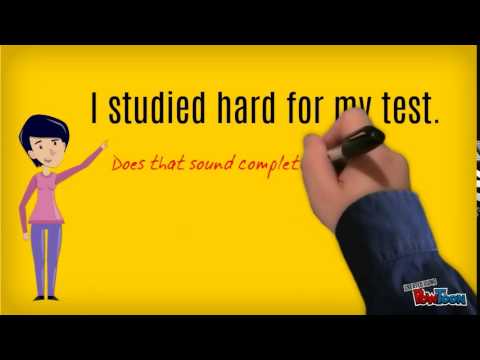3.02: Chapter 9: The Basic Elements of a Sentence
- Page ID
- 134476
10
Chapter 9: The Basic Elements of a Sentence
Rebekah Bennetch, Corey Owen, and Zachary Keesey
Learning Objectives
By the end of this chapter, you should be able to:
- Recognize the difference between a clause and phrase
- Distinguish between an independent clause and a dependent clause
- Identify and explain the four different sentence structures (simple, compound, complex, compound-complex)
Key Terms and Concepts
- phrase
- clause
- independent clause
- dependent clause
- coordinating conjunction
- subordinate conjunction
Exercise #1: Grammar Vocabulary Self-Assessment
Below you will see some flash cards with grammatical terms. These are all terms that we will mention through out this technical writing section. Try to predict what you think these words mean. If you can’t define the word, can you come up with an example? If the definitions don’t make sense yet, that’s okay! We’ll go into these things later. This assessment is just for your to test your own knowledge.
Clauses and Phrases
When building anything, be it a car, a house, or even a sentence, it is important to be familiar with the tools you are using. For this course, grammatical elements are the main “tools” you use when when building sentences and longer written works such as reports. Thus, it is critical to have some understanding of grammatical terminology in order to construct effective sentences. If you would like to review some basic parts of speech (nouns, pronouns, articles, adjectives, adverbs, prepositions, etc), see the Parts of Speech Overview at the Purdue OWL website. Now let’s get into it!
The two essential parts of a sentence are the subject and the verb. The subject refers to the topic being discussed while the verb conveys the action or state of being expressed in the sentence. When you combine these two elements, you get a clause. All clauses must contain both a subject and a verb.
Here are two simple examples of a clause.
(1) I walk.(2) I eat food. Both sentences have a subject and a verb, so they are clauses. There are two types of clauses in writing: an independent clause and a dependent clause.
There are also phrases, which lack either a subject or a verb, or both, so they need to relate to or modify other parts of the sentence. Don’t worry about that too much about phrases though. We are going to focus on clauses here.
Independentclauses, also called main clauses, can stand on their own and convey an idea. Let’s look at some examples.
Here is a sentence:
The engineers stood around the table looking at schematics for the machine.Can you identify the subject, verb, clause, and phrase in that sentence? If not, that’s okay.
Here’s a break down of the difference parts of the sentence.

Notice the independent clause [The engineers stood around the table] is a complete idea. If we took at the phrase, the independent clause would work as a complete sentence. The phrase [looking at schematics for the machine] is not. It has a verb [looking], but not a subject, which is why it isn’t a clause. It could not be a complete sentence on its own.
Dependentclauses rely on another part of the sentence for meaning and can’t stand on their own.
Here’s an example:
After they discussed different options, they decided to re-design the the components.Can you identify the different parts we have discussed so far? Below is a break down of the sentence.

Sentence 2 has one dependent clause and one independent clause, each with its own subject-verb combination [“they discussed” and “they decided”]. The two clauses are joined by the subordinate conjunction, “after,” which makes the first clause subordinate to (or dependent upon) the second one.
Being able to identify the critical parts of the sentence will help you design sentences that have a clear and effective subject-verb relationship.
If you need some more guidance on clauses, please watch one or both of the videos below. The first video takes a humorous approach, while the second is more formal.
Link to Original Video: https://tinyurl.com/holidayclause
Link to Original Video: https://tinyurl.com/indepclauses
Exercise #2: Identify the Clause
In this activity, you will identify all the words in either the independent clause or dependent clause in a sentence. You must click on all the words that are part of that clause to get the points.
For example, if you are supposed to identify an independent clause, and your sentence is
I will go to work after I eat breakfast.
you would click on “I” “will” “go” “to” and “work”
If you are supposed to identify a dependent clause for the same sentence, you would click on “after” “I” “eat” and “breakfast”.
The original version of this chapter contained H5P content. You may want to remove or replace this element.
Sentence Structures
Sentence structures are how we combine independent clauses, dependent clauses, and phrases to create complete ideas in our writing. There are four main types of sentence structures: simple, compound, complex, and compound-complex. In the examples above, Sentence 1 is a simple sentence, while Sentence 2 is complex.
We will go over each sentence structure now.
SIMPLE SENTENCES have one main clause clause and any number of phrases. Below is the formula for a simple sentence.
The following are all examples of simple sentences:
- A simple sentence can be very effective.
- It makes one direct point.
- It is good for creating emphasis and clarity.
- Too many in a row can sound repetitive and choppy.
- Varied sentence structure sounds more natural.
Can you identify the subject, verb, and phrases (if any) in the above sentences?
COMPOUND SENTENCES have two or more main clauses joined by coordinatingconjunctions (CC) such as and, but, for, yet, nor, or, so. A common acronym for remembering all of the conjunctions is FANBOYS. You can also connect them using punctuation such as a semi-colon or a colon. By coordinating the ideas, you are giving them roughly equal weight and importance.
Please note that these coordinating conjunctions are different from subordinate conjunctions, which show a generally unequal relationship between the clauses.
Below is the formula for a compound sentence:
- A compound sentence coordinates two ideas, and each idea is given roughly equal weight.
- The two ideas are closely related, so you don’t want to separate them with a period.
- The two clauses make up part of the same idea, so they should be part of the same sentence.
- The two clauses may express a parallel idea, and they might also have a parallel structure.
- You must remember to include the coordinating conjunction, or you may commit a comma splice.
In formal writing, avoid beginning a sentence with a coordinating conjunction.
COMPLEX SENTENCES express complex and usually unequal relationships between ideas. One idea is “subordinated” to the main idea by using a subordinate conjunction (like “while” or “although”). One idea is “dependent” upon the other one for logic and completeness. Complex sentences include one main clause and at least one dependent clause (see Example 2 above). Often, it is stylistically effective to begin your sentence with the dependent clause, and place the main clause at the end for emphasis.
The following are all examples of complex sentences. Subordinate conjunctions are in bold.
- When you make a complex sentence, you subordinate one idea to another.
- If you place the subordinate clause first, you give added emphasis to the main clause at the end.
- Subordinate clauses cannot stand on their own. Despite the fact that many students try to use them that way.x (fragment – replace the period with a comma to fix this error)
Check out this link for a list of subordinate conjunctions if you would like to see more examples.
COMPOUND-COMPLEX SENTENCES have at least two independent clauses and at least one dependent clause. Because a compound-complex sentence is usually quite long, you must be careful that it makes sense; it is easy for the reader to get lost in a long sentence. Given the complex nature of the structure, let’s look at a few examples and break them down into their parts
Independent Clause #1: Alphonse doesn’t like action movies.
Dependent Clause: because they are so loud
Independent Clause #2: he doesn’t watch them.
Dependent Clause: Although it will be close
Independent Clause #1: I think we will meet the deadline
Independent Clause #2: we will complete the project.
While our supervisor can be a bit of a jerk at times, he genuinely cares about the work and he wants to see us succeed.
Dependent Clause: While our supervisor can be a bit of a jerk at times
Independent Clause #1: he genuinely cares about the work
Independent Clause #2: he wants to see us succeed
EXERCISE #3 Identifying Sentence Types
Read the sentences below and identify which sentence structure is being used.
The original version of this chapter contained H5P content. You may want to remove or replace this element.
EXERCISE #4: Combining sentences
Below are two sentences separated by a line ( | ). Combine the pair of sentences to make one idea subordinate to the other. You can do this by either writing them down, or thinking it in your brain. When you have an answer, click on the sentences to see two possible answers.
Notice the impression you convey by how you subordinate one idea to another. If your combined sentence was a topic sentence for a paragraph, what idea would the reader expect that paragraph to emphasize?
The original version of this chapter contained H5P content. You may want to remove or replace this element.
Now that you have an idea of different sentence structures, let’s focus on specific issues that can damage your writing. Below, you will find links to other chapters, each with it’s own specific writing focus. Since everyone’s needs are going to be different, we want you to focus on one chapter that you think you need the most help with. Each section will have activities for you to do to check your understanding of the content.
If you’re not sure which to choose, ask your self the questions below. If you don’t know the answer, then click the link to be taken to the appropriate section.
- Are your sentences often too short, and not conveying complete ideas? (Sentence Fragments)
- Do you write in long, confusing sentences and not know how to break them up? (Run-On Sentences)
- When is it appropriate to use the passive voice? Is a nominalization a good thing? (Verb Tense)
- Do you know how to use a semicolon or colon? (Punctuation)
- Have you ever been told that your writing needs to be trimmed down? (Eliminating Wordiness)
Key Takeaways
- A sentence must have a subject and verb to form a complete idea.
- A clause has both a subject and verb. There are two types of clauses: an independent clause (which can stand alone) and a dependent clause (which can not stand alone).
- Using a variety of sentence types as well as using these types strategically to convey your ideas will strengthen your style. Keep the following in mind:
- Simple sentences are great for emphasis. The make great topic sentences.
- Compound sentences balance ideas; they are great for conveying the equal importance of related ideas.
- Complex sentences, when you use them effectively, show complicated relationships between ideas by subordinating one idea to another.
- Compound-complex sentences can add complexity to your writing, but you need be make sure it the writing doesn’t lose the reader.
- Ultimately, using a combination of these structures will make your writing stronger.
References
Purdue Writing Lab. (n.d.). Parts of speech overview. https://owl.purdue.edu/owl/general_writing/mechanics/parts_of_speech_overview.html
Attributions
This chapter is adapted from “Technical Writing Essentials” by Suzan Last (onBCcampus). It is licensed under Creative Commons Attribution 4.0 International License.



